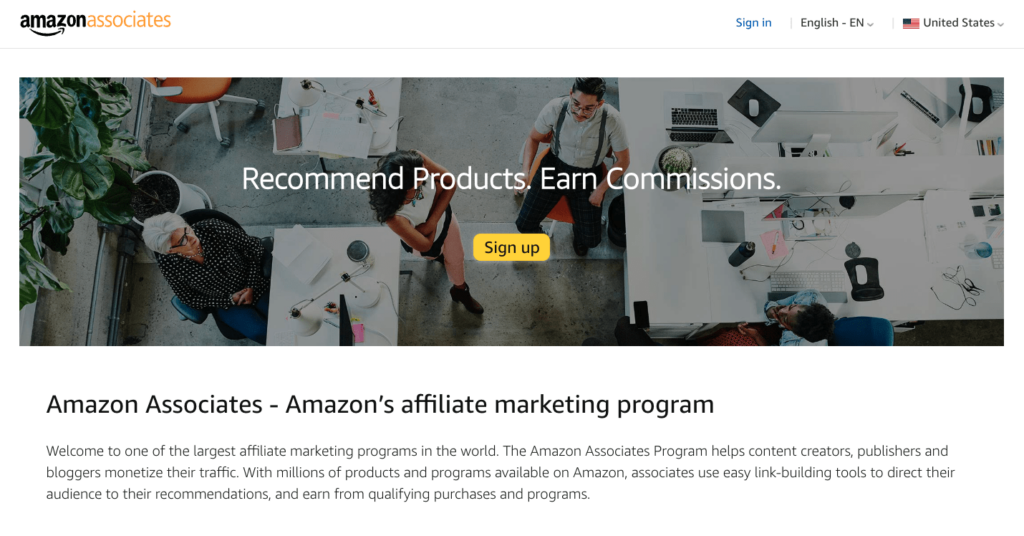Affiliate marketing has emerged as a powerful way for individuals to generate income by promoting products they believe in. If you’re intrigued by the idea of creating a revenue stream through affiliate marketing, building an Amazon Affiliate website is a fantastic place to start.
In this digital era, where e-commerce reigns supreme, Amazon stands as a global giant. The Amazon Associates program, more commonly known as the Amazon Affiliate program, allows you to partner with this e-commerce behemoth and earn commissions on sales made through your affiliate links.
Whether you’re a seasoned digital marketer or a newbie to the world of online business, creating an Amazon Affiliate website can be a game-changer in your quest for passive income.
This guide is your roadmap to success. We’ll walk you through the essential steps, strategies, and insider tips needed to create an Amazon Affiliate website that not only complies with Amazon’s policies but also maximizes your earnings potential. You’ll learn how to choose a niche, create engaging content, drive traffic, and optimize for conversions.
What is Amazon Associates?

Amazon Associates, also known as the Amazon Affiliate Program, is an affiliate marketing program offered by Amazon, the global e-commerce giant. It was established in 1996 and has since grown to become one of the most popular and accessible affiliate marketing programs on the internet.
The program enables individuals, content creators, and website owners to collaborate with Amazon in promoting a vast range of products available on the Amazon platform. In return, affiliates earn commissions for driving traffic and sales to Amazon through their unique referral links.
Essentially, Amazon Associates allows you to earn money by marketing Amazon products to your audience.
How Does Amazon Associates Work?

Participating in the Amazon Associates program involves a straightforward process:
Step 1: Sign Up
To begin, you need to sign up for the Amazon Associates program through the Amazon website. During the registration process, you will be required to provide some basic information about your website or promotional methods. You will also need to select your preferred payment method, which can be via check, direct deposit, or Amazon gift cards.
Step 2: Choose Products
After you’ve registered as an Amazon Associate, you will then gain access to Amazon’s vast catalogue of products. Here, you can select the specific items that you want to promote on your website, blog, or social media channels. The products you choose can be from various categories, including electronics, fashion, books, and more.
Step 3: Create Affiliate Links
For each product you wish to promote, you’ll receive a unique affiliate tracking ID or link. This ID is embedded within your affiliate links. When users click on these links and make a purchase on Amazon, the system can attribute the sale to you, allowing you to earn a commission.
Step 4: Promote Products
Your primary responsibility as an Amazon Associate is to promote the selected products effectively. This involves creating content that incorporates your affiliate links, such as product reviews, buying guides, or recommendations. The goal is to make your content engaging and valuable to your audience so that they are more likely to click on your affiliate links and make a purchase.
Step 5: Earn Commissions
When a visitor to your website or social media platform clicks on one of your affiliate links and makes a purchase on Amazon, you earn a commission. The commission rates vary based on the product category and the number of products sold. Over time, as you drive more sales and referrals, you can qualify for higher commission percentages.
Step 6: Track and Optimize
Amazon Associates provides comprehensive reporting tools that allow you to monitor the performance of your affiliate links. This data can help you assess what’s working and what isn’t, enabling you to optimize your promotional strategies for better results.
Pros and cons of Becoming an Amazon Associates

Becoming an Amazon affiliate can be a potentially lucrative venture, but it’s essential to understand the pros and cons before diving in. Here’s a detailed look at the advantages and disadvantages of joining the Amazon Associates program:
Pros of Becoming an Amazon Affiliate:
Access to a Vast Product Catalog: Amazon offers a vast selection of products across virtually every category imaginable. This extensive catalogue gives you the flexibility to choose products that align with your niche or target audience.
Trust and Credibility: Amazon is a highly trusted and recognized e-commerce platform. Associating your affiliate marketing efforts with a reputable brand can also enhance your credibility and build trust with your audience.
Global Reach: Amazon operates in many countries worldwide. As an Amazon affiliate, you can then potentially tap into a global customer base, which means more opportunities for earning commissions.
Passive Income Potential: Once you create and publish content with affiliate links, those links can continue to generate income over time, even when you’re not actively promoting them. This passive income potential is an attractive aspect of affiliate marketing.
Easy to Get Started: The Amazon Associates program is beginner-friendly. Setting up an account and then, generating affiliate links is relatively easy, making it accessible to people with minimal technical skills.
Diverse Marketing Options: You can promote Amazon products through various methods, including websites, blogs, social media, email marketing, and more. This flexibility allows you to choose the marketing strategies that best suit your skills and resources.
Revenue from Multiple Purchases: When a user clicks on your affiliate link and makes a purchase on Amazon, you earn a commission not only on the specific product you promoted but also on any other products the user adds to their cart during that session. This can significantly increase your earnings.
Cons of Becoming an Amazon Affiliate:
Low Commission Rates: One of the primary drawbacks of the Amazon Associates program is its relatively low commission rates, especially for certain product categories. While the rates can increase with higher sales volume, starting out may not be very profitable.
Cookie Duration: Amazon’s affiliate program uses a 24-hour cookie duration. This means that you’ll only earn a commission if a user makes a purchase within 24 hours of clicking your affiliate link. Other affiliate programs offer longer cookie durations, which can be more advantageous.
Changing Commission Structure: Amazon has been known to adjust its commission rates, and these changes can impact your earnings. It’s essential to stay informed about any updates to the program’s terms and conditions.
Product Availability and Price Changes: Products on Amazon can become unavailable or change in price, which can lead to broken links or discrepancies in your affiliate content. This requires regular monitoring and updates to ensure your affiliate links remain relevant.
High Payout Threshold: Amazon Associates has a minimum payout threshold that you must reach before receiving your earnings. If you don’t generate enough sales, it may take a while to reach this threshold and receive a payment.
Competition: Amazon’s popularity means that there is substantial competition among affiliates. You’ll be competing with numerous other affiliates, making it essential to create high-quality, engaging content to stand out.
Geographic Limitations: The Amazon Associates program operates independently in various countries. You may need to sign up for different country-specific programs to target international audiences, which can add complexity to your affiliate marketing efforts.
Becoming an Amazon affiliate has both advantages and disadvantages. While it offers a vast product catalogue and the potential for passive income, you should be aware of the low commission rates, changing terms, and competition in the market.
How Much Can Amazon Affiliates Make?
As you are promoting mostly physical products for the Amazon associates program, the commission rates are relatively lower due to the limited margin for physical products.
Amazon Games has the highest commission rate, which is currently set at 20%. Luxury Beauty follows with a commission rate of 10%. Other categories, like Televisions, Digital Video Games and Furniture, have lower affiliate payouts.
You need to understand the commission rate well so you can know which product you should focus on more.
The income potential for Amazon affiliates, like any affiliate marketing program, varies widely and depends on several factors. Earnings can range from a modest supplementary income to a substantial full-time income, and even some top-tier affiliates make a significant living from their efforts.
Let’s delve into the key factors that influence how much Amazon affiliates can make:
1. Traffic and Click-Through Rates (CTRs)
The primary determinant of your Amazon affiliate earnings is the volume of traffic your website or content generates. A higher number of visitors clicking on your affiliate links can result in more conversions and, consequently, increased earnings.
Besides, your click-through rates (CTR) play a pivotal role here. If you can create content that encourages users to click on your affiliate links, you’ll have a better chance of generating income.
2. Product Selection and Niche
The types of products you choose to promote can significantly impact your earnings. High-ticket items, such as electronics and appliances, can yield more substantial commissions compared to lower-cost products like books or toys.
In addition, your niche selection is also crucial. Focusing on a niche with a passionate and engaged audience can lead to higher conversion rates, as your content resonates more with your target audience.
3. Commission Rates and Volume
Amazon offers different commission rates for various product categories, and these rates can fluctuate over time. Some categories offer higher percentages, while others provide lower commissions.
Besides, your earnings also depend on the volume of products sold through your affiliate links. As you generate more sales and reach higher tiers within the program, your commission rates can increase, potentially boosting your income.
In short, the income potential for Amazon affiliates varies based on the volume of traffic, click-through rates, product selection, and commission rates offered by Amazon. While some affiliates earn a few hundred dollars per month, others can generate thousands or even more.
Success as an Amazon affiliate often requires creating high-quality, niche-specific content, optimizing conversion strategies, and staying up-to-date with changes in Amazon’s affiliate program to maximize your earnings. Ultimately, your income as an Amazon affiliate is a reflection of the effort, strategy, and skills you invest in your affiliate marketing endeavours.
What is an Amazon Affiliate Website?

An Amazon affiliate website is a type of online platform or digital property created with the primary purpose of promoting and selling products available on Amazon.com through affiliate marketing. In addition, these websites are owned and operated by individuals or businesses who have joined the Amazon Associates program, commonly referred to as Amazon Affiliates.
The goal of an Amazon affiliate website is to earn commissions by driving traffic to Amazon and encouraging users to make purchases using the affiliate’s unique referral links.
These websites typically feature a variety of content designed to attract and engage users. Besides, content can include product reviews, buying guides, tutorials, product comparisons, and other informational or promotional materials related to the products available on Amazon.
The affiliate strategically incorporates affiliate links within the content, directing visitors to specific Amazon product pages. When a visitor clicks on an affiliate link and subsequently makes a purchase on Amazon, the affiliate earns a commission, which is a percentage of the sale price or a fixed fee, depending on the product category.
Amazon affiliate websites can vary in focus and niche, covering a wide range of product categories and industries. Some websites may target specific niches, such as technology, health and fitness, or home improvement, while others may adopt a more general approach, promoting a broad array of products.
The success of these websites depends on their ability to generate high-quality content, attract organic traffic through search engine optimization (SEO) or other marketing strategies, and effectively convert that traffic into Amazon sales. Amazon affiliate websites have become a popular way for individuals and entrepreneurs to monetize their online presence and generate passive income through affiliate marketing.
How to Build an Amazon Affiliate Website

Now that you know what an Amazon affiliate website is, let’s walk you through the process of building one:
1. Choose a niche – Amazon Affiliate Website
Selecting the ideal niche for your Amazon Associate website is a crucial decision that can significantly impact the success of your affiliate marketing venture. Here’s how to choose the right niche for your Amazon Associate website:
Identify Your Interests and Passions
Firstly, start by considering your personal interests and passions. Basically, the niche you choose should align with your own hobbies and interests, as this will make the content creation process more enjoyable and sustainable.
Your enthusiasm will shine through in your writing, and you’ll have a deeper understanding of the niche. This can be beneficial for engaging your target audience.
Market Research and Demand
Conduct thorough market research to gauge the demand and profitability of potential niches. Utilize keyword research tools, Google Trends, and forums to identify niches with growing or stable interest.
Then, assess the competition within these niches as well, as high competition might make it harder to stand out. Striking a balance between demand and competition is key to success.
Consider Monetization Potential
Evaluate the monetization potential of the niche. Some niches offer higher commissions due to the price point of the products they encompass. Others may provide lower commissions but have consistent sales due to a wider target audience. Consider the long-term revenue potential of your chosen niche to ensure it aligns with your income goals.
2. Pick a web hosting provider – Amazon Affiliate Website
Selecting the right hosting for your Amazon Associate website is a crucial step in establishing a strong online presence. Here’s a concise guide, using Bluehost as an example, to help you pick the best hosting for your affiliate website:
Hosting with Bluehost: Bluehost is a well-regarded hosting provider known for its reliability and user-friendly features. To get started, visit the Bluehost website and choose a hosting plan that suits your website’s needs.
They offer various hosting options, including shared hosting, which is suitable for most affiliate websites. Once you’ve selected a plan, you can proceed with the domain registration or connect an existing domain if you already have one.

Bluehost offers one-click WordPress installation, making it easy to set up your Amazon Associate website.

Additional Features and Support: Bluehost provides a range of features and tools to support your website. These include a free SSL certificate for secure browsing, automatic WordPress updates, and customer support.
Their 24/7 customer support can assist you with any hosting or domain-related questions or issues. As your Amazon Associate website grows, Bluehost offers scalability options, allowing you to upgrade your hosting plan to accommodate increased traffic and resource requirements.
3. Choose A Domain Name – Amazon Affiliate Website
Selecting the perfect domain name for your Amazon Associate website is a critical decision, as it directly impacts your site’s branding, discoverability, and overall success. Here’s a brief guide to help you choose the right domain for your affiliate website:
When deciding on a domain name, prioritize relevance to your niche and the products you intend to promote as an Amazon Associate. The domain should clearly convey the focus of your website and the nature of the products you’ll be endorsing.
Then, aim for a domain name that is easy to remember and type. Avoid complex or lengthy names, as they may be challenging for visitors to recall. Simplicity is key to ensuring that your audience can quickly access your website. Namecheap, a reputable domain name registrar, offers a domain registration service where you can effortlessly search for available domain names and determine their memorability.
While the traditional “.com” domain extension is often recommended for its familiarity, other extensions like “.net,” “.org,” and others can also work well if the “.com” version is unavailable. Bluehost assists in checking domain availability and helps you secure your chosen domain extension.
4. Decide on a Theme – Amazon Affiliate Website
Start by considering the relevance of the theme to your chosen niche. The theme’s design and features should align with the products and content you plan to promote. For instance, if you’re focusing on technology products, look for a theme with a modern and tech-savvy design. Themes should complement your niche, not distract from it.

Then, ensure the theme you choose is mobile-responsive. With a growing number of users accessing websites on smartphones and tablets, a responsive theme is essential for providing a consistent and user-friendly experience across all devices. This is not only important for user satisfaction but also for SEO, as search engines prioritize mobile-friendly websites.
Finally, look for a theme that allows for easy customization. Themes with customization options, such as the ability to modify colours, fonts, and layouts, will give you the flexibility to create a unique and branded look for your Amazon Associate website.
Additionally, consider themes that offer compatibility with essential plugins and SEO optimization features to enhance your site’s functionality and search engine visibility.
Alternatively, you can even use WordPress plugins like AzonPress to effortlessly embed Amazon affiliate links onto your site.
5. Craft Compelling Content – Amazon Affiliate Website
Crafting compelling content for an Amazon Associate website is essential for driving traffic and increasing affiliate sales. To do this effectively, start by thoroughly researching your niche and target audience. Understand what products or categories are popular within your niche, and identify the specific needs and problems your audience has.
Use keyword research tools to find relevant keywords and phrases that people are searching for in your niche. This will help you create content that is not only interesting but also optimized for search engines.
Once you’ve gathered the necessary information, plan your content strategy. Create a content calendar that includes a variety of content types, such as product reviews, buying guides, how-to articles, and informative blog posts. Make sure your content is informative, engaging, and valuable to your readers. For product reviews, provide detailed information about the products, their features, pros and cons, and your personal recommendations. When creating buying guides, offer product comparisons, best picks, and tips for making informed purchasing decisions. In blog posts, address common questions and concerns within your niche to position yourself as an authority in the field.
Promote trust and transparency in your content. Disclose your affiliation with Amazon Associates and ensure your audience knows that you may earn a commission from the products you recommend. Be honest and unbiased in your reviews and recommendations to build credibility. Additionally, use high-quality images and videos to enhance your content, and include affiliate links strategically within the text. It’s crucial to track your content’s performance using tools like Google Analytics and Amazon Associate reports to refine your strategies over time. By consistently delivering valuable, well-researched, and transparent content, you can engage your audience, build trust, and boost your Amazon affiliate earnings.
6. Drive Traffic to your site – Amazon Affiliate Website
Driving traffic to your Amazon Associate website is essential for earning affiliate commissions. To effectively promote your affiliate site and attract visitors, you can employ various strategies and techniques. Here are some key steps to help you increase traffic to your Amazon Associate website:
Create High-Quality Content:
Start by producing valuable and relevant content that appeals to your target audience. Write product reviews, how-to guides, or informative articles related to the products you’re promoting. Quality content not only helps with search engine optimization (SEO) but also engages your readers.
Optimize for SEO:
Implement on-page SEO techniques, including optimizing your content for relevant keywords and phrases. For that reason, you may use SEO plugins or tools to improve your website’s search engine rankings, making it more likely to appear in search results.
Leverage Social Media:
Besides, establishing a strong presence on social media platforms like Facebook, Twitter, Instagram, and Pinterest will help in getting more traffic. Share your content, engage with your audience, and use popular hashtags to increase visibility and reach a broader audience.
Email Marketing
Build an email list by offering visitors a subscription option on your site. Send out regular newsletters with updates, promotions, and valuable content. Email marketing can be a powerful tool for driving repeat traffic to your website.
Paid Advertising
Consider using paid advertising channels like Google Ads or Facebook Ads. These platforms allow you to target specific demographics and interests, which can be especially effective for promoting affiliate products.
Collaborate with Influencers
Also, you can partner with influencers in your niche who can promote your website or specific products. Influencers can help you tap into their followers’ trust and loyalty.
Guest Blogging
In addition, contribute guest posts to other websites or blogs within your niche. You can then do that by including a link to your Amazon Associate site in your author bio or within the content, if relevant. This can also help you reach a broader audience and establish authority in your niche.
Networking and Building Relationships
Attend industry-related events, join forums, and connect with others in your field. Building strong relationships with other bloggers, website owners, and affiliates can lead to guest posting opportunities and cross-promotion.
Amazon Affiliate Eligibility Guidelines

Amazon Associates, the affiliate marketing program offered by Amazon, has specific eligibility guidelines that potential affiliates must adhere to. These guidelines are in place to ensure the integrity of the program and to maintain a high standard of quality and trustworthiness for both affiliates and Amazon. Here’s an explanation of some key Amazon affiliate eligibility guidelines:
Website or Blog Requirements:
To become an Amazon affiliate, you must have an active, well-established website, blog, or app that complies with Amazon’s guidelines. Your site should have original, high-quality content and a reasonable number of visitors. Amazon generally does not accept affiliates with websites that are under construction or primarily focused on low-quality content.
Geographic Location:
Amazon Associates is open to affiliates from various countries, but not all. You must reside in a region or country where the program is available. Additionally, you need to provide accurate tax and payment information, as this varies by location.
Age Requirement:
You must be at least 18 years old to participate in the Amazon Associates program. Minors are not eligible to apply, and it’s important to use accurate personal information during the application process.
Content Guidelines:
Your website or blog content must be appropriate and in compliance with Amazon’s content guidelines. This will also include avoiding explicit, offensive, or illegal material and ensuring that your site is suitable for all audiences.
No Violation of Amazon Policies:
You must not violate any of Amazon’s policies, including the Associates Program Operating Agreement. This means you should follow all guidelines related to promoting Amazon products, using affiliate links, and handling customer data.
Disclosure Requirements:
Amazon requires affiliates to clearly disclose their affiliate status on their websites or in content where they promote Amazon products. This disclosure is usually made through a disclaimer or disclosure statement explaining that you may earn commissions from Amazon for purchases made through affiliate links.
Limited Use of Amazon Trademarks:
Affiliates are allowed to use Amazon’s product images, descriptions, and trademarks within the guidelines provided by Amazon. However, you cannot modify Amazon trademarks or present them in a way that may confuse consumers.
Prohibited Content:
Certain types of content are not allowed in the Amazon Associates program. This includes content that promotes violence, discrimination, or illegal activities, as well as content that infringes on the intellectual property rights of others.
Follow FTC Guidelines:
In the United States, the Federal Trade Commission (FTC) has guidelines for affiliate marketing disclosure. Amazon affiliates in the U.S. must comply with these guidelines, which include clearly disclosing their affiliate relationship and the potential to earn commissions.
It’s essential for prospective Amazon affiliates to thoroughly review Amazon’s official guidelines and the Associates Program Operating Agreement before applying. Understanding and adhering to these guidelines not only ensures your eligibility but also helps maintain a positive and compliant affiliate marketing relationship with Amazon. Violations of these guidelines can lead to account termination and the loss of affiliate earnings.
Final thoughts: How to build an Amazon Affiliate Website: Step-by-step guide
Creating your Amazon Affiliate website is a journey that offers exciting opportunities for financial independence and personal growth. As we come to the end of this guide, we hope you’ve found the information and insights valuable in your quest to establish a successful affiliate marketing venture with Amazon.
Keep in mind the key takeaways from this guide:
Firstly, choose the Right Niche: Select a niche that you are passionate about and has a market for Amazon products. Your enthusiasm will shine through in your content.
Secondly, create High-Quality Content: Consistently produce valuable, informative, and engaging content that resonates with your audience.
Thirdly, optimize for SEO: Master the art of search engine optimization to improve your website’s visibility and drive organic traffic.
Then, promote on Multiple Platforms: Utilize social media, email marketing, and other promotional channels to reach a broader audience.
Following by compliance and Transparency: Always adhere to Amazon’s policies and disclose your affiliate status to build trust with your audience.
Finally, stay Informed: The world of online marketing is dynamic. Keep learning, experimenting, and adapting your strategies to stay competitive.





